Rubber Dictionary
+ - Acrylonitrile butadiene rubber (NBR)
Through the copolymerisation of acrylonitrile and butadiene acrylonitrile butadiene rubber (nitrile rubber) is obtained, an extraordinary good mineral oil and fuel resistance as well as a low pressure permanent set. NBR is thus the ideal oil and fuel resistant sealing material. NBR rubber is, however, not very ozone resistant.
NBR is for Shore-hardness Shore A 30-95 available.
Areas of application: oil and fuel resistant seals, membranes, hoses.
+ - AdBlue®
AdBlue® is an aqueous, colorless and odorless urea solution consisting of 32.5 percent of high-purity, crystalline urea and 67.5 percent demineralized water. With the urea solution the emission of nitrogen oxides (NOx) is reduced by up to 90 percent for diesel engines. The waterclear liquid is injected into the exhaust line and leads to a selective catalytic reaction (SCR). Thereby Nitrogen oxides and ammonia are converted into harmless water and Nitrogen.
+ - Adhesive agent
Adhesive agents are polar dispersions of polymers, pigments and binders. A distinction is made between adhesive agents based on solvents and watery adhesive agents and between one component and two component adhesive systems.
With two component adhesive systems first a so-called primer is applied to the pre-treated metal surface. After the primer has dried, the application of the actual adhesive agent follows.
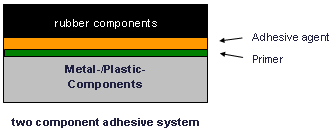
+ - Butyl rubber (IIR)
Compared to NR and other synthesis rubbers, butyl rubber has a very low permeability for air, water steam and other gases. Further advantages are very good resistance to heat, oxygen, ozone and chemicals.
IIR is for Shore-hardness Shore A 30-80 available.
Areas of application: Everywhere where low gas permeability and good heat and ageing resistance is demanded, like e.g. with car hoses, inner coatings of tyres without tubes, acid protective clothing, seals and membranes etc. Further possibilities for use in the cable industry as well as for electric insulation.
+ - Chloroprene rubber (CR)
In practice, CR is very often familiar under trade names like e.g. Neoprene (DU PONT). CR has rather balanced characteristics. Through the corresponding protective means, a rather good ozone and ageing resistance and a satisfactory oil resistance can be achieved. As opposed to NR, a high mechanical value can also be reached "unfilled" with CR and the other synthesis rubber types. Due to its high chlorine contents, CR is flame retardant. It burns within a flame but is extinguished if the flame is removed.
CR is for Shore-hardness Shore A 25-90 available.
Areas of application: Everywhere where flame resistance, good ageing characteristics as well as chemical resistance are necessary, like e.g. conveyor belts, seals, hoses, roller covers, container coatings.
+ - Chlorosulfonated polyethylene (CSM)
Chlorosulfonated polyethylene is produced through the chemical treatment of polyethylene with gaseous chlorine and sulphur dioxide. The stiff, thermoplastic polyethylene becomes a flexible, vulcanizable rubber. Analogue to the chloroprene rubber (CR) the chlorine in CSM rubber leads to a good flame resistance and good mineral oil resistance. CSM is marketed by DuPont under the trade name "Hypalon".
CSM is for Shore-hardness Shore A 45-90 available.
Areas of application: Cable coatings, acid resistant hoses, container coverings, seals, membranes.
+ - Cold runner
Low temperature sprueing area of a mould in which the vulcanization of the elastomer mixture in it is prevented. With a cold runner the resulting amount of vulcanized waste can be substantially reduced in the production of rubber moulded parts since the unvulcanized material in the channels can be used for the production of moulded parts. Depending on the type of construction a distinction is made between the nozzle cold runners and transfer moulding cold runners.
+ - Compression moulding process (CM)
The compression moulding or pressing process is the traditional process for the production of rubber moulded parts. An amount which corresponds with the finished part of the unvulcanized rubber mixture is usually manually added to the heated vulcanisation mould.
The mould is then shut under pressure in a press. Through the mould pressure and the temperature, the mixture softens, flows and fills the mould part hollow room (nest). At temperatures of 140 - 200°C, the Vulcanisation of the rubber mixture takes place. The vulcanized (cross-linked) moulded part is then taken out hot. As opposed to the Injection moulding process (IM) the CM process in general requires clearly longer heating times since the heating of the added cold rubber mixture to the vulcanization temperature follows exclusively from the mould wall. A further development of the CM process is the Compression transfer moulding process (CTM).

+ - Compression Set (CS)
The Compression Set shows to which extent a compressed material recovers after a certain time and a certain temperature.
A Compression Set of eg. 0% means that the material recovers to 100%. If the CS is 100% the material does not recover at all.
The CS values are very important for sealing applications or anti-vibration elements.
+ - Compression transfer moulding process (CTM)
The compression transfer moulding process (CTM) is an injection press process with which the rubber mixture placed in the upper part of a vulcanization mould is injected (transferred) when applying the press through channels in the mould cavity. CTM vulcanization moulds are made up of three parts (upper, middle, lower part).
Compared to Compression moulding (CM) or press processes the vulcanization time is shortened since the rubber mixture is additionally heated up through the occuring frictional heat from the injection in the cavities. The transfer unit found in the upper part of the mould can also be filled through the injection aggregate of an injection moulding machine. One then speaks of Injection transfer moulding process (ITM).
Transfer moulding processes are especially suitable for the production of small rubber moulded parts in moulds with many cavities. A disadvantage of the CTM or ITM process is the high filling amount of unvulcanized elastomer material in the transfer unit. Through the use of transfer moulding cold runners the waste amount can however be substantially reduced.
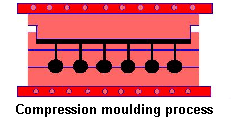
+ - Degreasing
The degreasing and preliminary treatment of metal surfaces is a basic prerequisite in order to create a rubber metal compound which is capable of a burden. This preliminary treatment can be carried out both mechanically (blasting process) as well as chemically.
+ - Degreasing metal parts
Metal parts are usually covered with oil or grease layers when delivered. These are often remains of cooling lubricants used in the production (turning or milling processing) or of means to protect against corrosion. To degrease organic solvents or watery alcaline solutions of cleaning agents are used.
+ - DIN ISO 3302-1
Tolerances for rubber moulded parts
Rubber moulded parts are tolerated according to DIN ISO 3302-1. A distinction is made between 4 tolerance classes from M1 = fine to M4 = coarse. Depending on the press direction of the mould, the norm in addition distinguishes between dimensions bound to the mould (F) and the two component adhesion system measurements bound to the mould closure (C). Depending on the process, the dimensions bound to the mould closure (C) are tolerated more largely than the dimensions bound to the mould (F).
Technical rubber moulded parts are normally tolerated according to the tolerance class M3 = middle.
| Basic size | Tolerance class M1 (very fine) |
Tolerance class M2 (fine) |
Tolerance class M3 (middle) |
Tolerance class M4 (coarse) |
||||
|---|---|---|---|---|---|---|---|---|
| over | upto | F | C | F | C | F | C | F + C |
| 0 | 4,0 | ± 0,08 | ± 0,10 | ± 0,10 | ± 0,15 | ± 0,25 | ± 0,40 | ± 0,50 |
| 4,0 | 6,3 | ± 0,10 | ± 0,12 | ± 0,15 | ± 0,20 | ± 0,25 | ± 0,40 | ± 0,50 |
| 6,3 | 10 | ± 0,10 | ± 0,15 | ± 0,20 | ± 0,20 | ± 0,30 | ± 0,50 | ± 0,70 |
| 10 | 16 | ± 0,15 | ± 0,20 | ± 0,20 | ± 0,25 | ± 0,40 | ± 0,60 | ± 0,80 |
| 16 | 25 | ± 0,20 | ± 0,20 | ± 0,25 | ± 0,35 | ± 0,50 | ± 0,80 | ± 1,00 |
| 25 | 40 | ± 0,20 | ± 0,25 | ± 0,35 | ± 0,40 | ± 0,60 | ± 1,00 | ± 1,30 |
| 40 | 63 | ± 0,25 | ± 0,35 | ± 0,40 | ± 0,50 | ± 0,80 | ± 1,30 | ± 1,60 |
| 63 | 100 | ± 0,35 | ± 0,40 | ± 0,50 | ± 0,70 | ± 1,00 | ± 1,60 | ± 2,00 |
| 100 | 160 | ± 0,40 | ± 0,50 | ± 0,70 | ± 0,80 | ± 1,30 | ± 2,00 | ± 2,50 |
| 160 | - | ± 0,3 % | ± 0,4 % | ± 0,5 % | ± 0,7 % | ± 0,8 % | ± 1,3 % | ± 1,5 % |
+ - DOTG
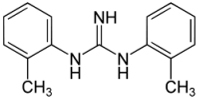 The abbreviation DOTG stands for the chemical composition N, N'-di-o-tolylguanidine. DOTG is mainly used in the rubber industry as vulcanisation accelerator in acrylate rubbers (ACM, AEM).
The abbreviation DOTG stands for the chemical composition N, N'-di-o-tolylguanidine. DOTG is mainly used in the rubber industry as vulcanisation accelerator in acrylate rubbers (ACM, AEM).
During processing and storage hazardous substances can be released from DOTG produced rubber parts. These substances are seen as a potential health risk in the rubber. Elastomer products free of DOTG are also increasingly demanded by the automotive industry.
Although, there is no legal restriction on the application of DOTG, the rubber industry has set itself the goal offering innovative accelerator systems for DOTG free acrylate rubber products.
+ - Elastomer mixture (compound)
Natural and synthesis rubbers are not materials in the generally common sense but rather only basic materials to which a number of mixture components must be added before the vulcanization. In addition to the basic material rubber, all elastmers contain numerous additions like fillers (e.g. soot), softeners, processing aids, aging protection means, vulcanization means, vulcanization accelerators, activators, vulcanization retarders, pigments etc. On average an elastomer mixture consists of 10 to 20 components. The total of all of these components is called the elastomer mixture or elastomer compound.
The used rubber determines the basic characteristics of the vulcanizate, above all the ageing resistance and the flexibility at cold tempertures as well as the conduct opposed to differing media like oils, fuels, water and solvents. The level of the mechanical characteristics like elasticity and sturdiness also depends on the polymer basis as well as on the filling with so-called reinforcing soots or light fillers. Using additional materials, certain characteristics can be varied (like the hardness) and improved (e.g. flexibility with coldness, impact elasticity, pressure permanent set, heat and swelling resistance. The mixture of elastomers is very complex and is adapted to the respective application.
+ - Elastomers
are polymers based on macromolecules which are cross-linked wide-meshed and three dimensionally through cross connections. This cross-linking of the individual polymer chains (vulcanization) leads to the rubber elastic characteristics of this material. In everyday language elastomers are therefore also called rubber.
+ - Elongation at break
The elongation at break or the ultimate elongation is a material characteristic which defines the existing elongation in the moment of rupture of a standardized test specimen. The elongation at break is a percentage in relation to the initial length before the elongation. Standard elatomers show an elongation at break between 100 and 800 %. In extreme cases this value can be considerably exceeded.
+ - Epichlorohydrin rubber (ECO)
Epichlodohydrin rubber unifies the good characteristics pertaining to mineral oil resistance and the low pressure permanent set of the NBR rubber with a good weather and ozone resistance. ECO mixtures need relatively long vulcanization times. Usually tempering of the vulcanized parts is necessary.
ECO is for Shore-hardness Shore A 40-90 available.
Areas of application: Seals, membranes, hoses and roll coverings. Use above all everywhere where good mineral oil resistance and at the same time good weather and ozone resistance are required.
+ - Ethylene acrylic elastomer (AEM)
Ethylene-acrylate rubber is a polymer of ethylene-methyl acrylate with carboxylic groups. AEM rubber has a better heat resistance than ACM. It also has a better tear strength, but a worse resistance to mineral oils than ACM. AEM as well as ACM is known under the trade name VAMAC ® from Dupont.
Operating temperature range is about - 40°C to +150°C.
AEM is available in the hardness ranges 40-90 Shore A.
Applications: automotive gaskets, hoses, O-rings.
+ - Ethylene propylene diene rubber (EPDM)
EPDM rubber is produced through copolymerisation of ethylene, propylene and a diene and can be cross-linked with sulphur or peroxides. Through cross-linking with peroxides, the resulting vulcanizate has an improved pressure permanent set. EPDM has a good oxygen, ozone and temperature resistance. The gluability of EPDM is strongly decreased due to the composition (ethylene, propylene). EPDM is characterised through an over-average chemical resistance, the mineral oil and grease resistance is however rather bad.
EPDM is for Shore-hardness Shore A 30-90 available.
Areas of application: In terms of quantity EPDM is mostly used in the automobile industry, e.g. for sealing profiles in doors and the boot, for windows and headlights, fender buffers, hoses and sealing elements. EPDM is also used with washing machines and dishwashers for seals and hoses due to its good hot water resistance. In addition EPDM has reached a high market share compared to CR as an excellent elastomer for building profiles due to its very good weather resistance.
+ - Fluoride rubber (FPM)
Fluoride rubbers are mixed polymers. The first type, a copolymer made of vinylidene fluoride and hexa fluoride propylene was introduced to the market in 1958 by DU PONT under the name of VITON. FPM is flame retardant and has a resistance which is superior to all elastomers against high temperatures, ozone, oxygen and chemicals.
FPM is for Shore-hardness Shore A 40-90 available.
Areas of application: Seals, moulded parts and hoses, cable isolation, everywhere where high temperatures and excellent chemical resistance is needed.
+ - Fluoride silicon rubber (FVMQ)
Fluoride silicon rubbers combine the good swelling resistance of the fluoride rubbers (FKM) with the low temperature flexibility (- 60 to +240°C) of silicon rubbers (VMQ). Like the silicon rubbers, also the fluoride silicon rubbers are cross-linked with peroxides.
FVMQ is for Shore-hardness Shore A 30-80 available.
Areas of application: Moulded parts with oil and fuel resistance with a wide temperature resistance range (e.g. aeronautics and space industry).
+ - Fringe projection
The digital fringe projection is a 3-D measurement for the non-contact digitalization of component surfaces.
With the help of a projector different light-dark fringe patterns are produced by the measuring part. A CCD camera missed the deflection of the fringe pattern. Then a digital 3D profile of the target is calculated via a mathematical calculation method.
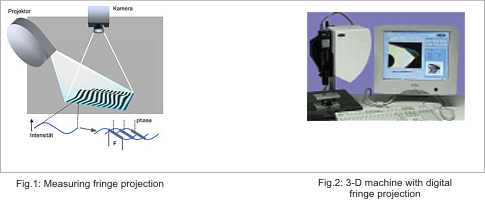
The digital fringe projection is especially suitable for non-contact measurement of micro-elastomer composites, because there isn´t any deformation of the elastomer component possible.
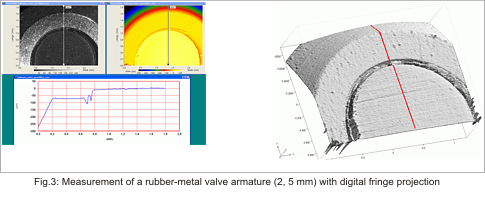
+ - Glycol
Di-alcohol (divalent alcohol) are named glycol, which is a derivate from ethylene-glycol. These glycol are used for anti-freezing or frost-protection agents reducing the freezing temperature of other substances (e.g. water) considerably.
Well-known is the application as addition for cooling or windscreen washer systems. A famous brand name under the frost protection agents is Glysantine, an existing trademark of BASF since 1929.
+ - Hydrogenated acrylonitrile butadiene rubber (HNBR)
Through the selective hydrogenation of nitrile rubber (NBR) its temperature resistance is clearly increased. While NBR can be used with permanent temperatures of up to 100°C, peroxidic cross-linked HNBR rubbers are resistant up to 150°C. HNBR in addition has good mechanical characteristics and a good ageing resistance compared to ozone.
HNBR is for Shore-hardness Shore A 45-98 available.
Areas of application: Drive belts as well as seals and hoses in lubrication, hydraulics, and the cooling area of vehicles.
+ - Injection moulding process (IM)
With injection moulding for the production of rubber moulded parts the rubber mixture is pre-heated in an injection moulding machine at first in a snail aggregate and plastified (80 - 100°C) and then injected through sprueing channels into the heated mould. Depending on the type of construction, a distinction is made between horizontal and vertical injection moulding machines. The injection process follows either through direct pushing of the snail in the cylinder or through the injection via a separate cylinder (injection pistons).
Compared to the compression moulding (CM) the IM process is the modern process for the production of rubber moulded parts. Through the plastification in the injection aggregate, compared to the CM process clearly reduced heating times are achieved. With the use of suitable handling technology for the removal of rubber moulded parts, also a fully automatic moulding process is possible.
The vulcanized elastomer material in the sprueing channels must be disposed of as vulcanization waste. Through the use of nozzle cold runners the waste amount can however be substantially reduced.
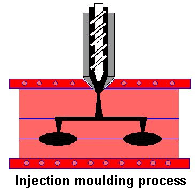
+ - Injection transfer moulding process (ITM)
The injection transfer moulding process (ITM) is a variation of the compression transfer moulding process (CTM) where the transfer unit in the top of the form will be filled with plastified rubber through the injection unit of the injection moulding machine. The transfer of already plastified rubber compound allows a smoother filling of the mould.
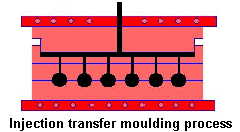
+ - Ink-test-method
Ink-test-method to define surface tension or freedom of grease, respectively.
You can determine the surface tension and, at the same time, the freedom of greaseof the surface of metal or plastic parts with the help of test inks. A coloured ink with adefined surface tension is applied to the surface to be tested with a brush. If the surface will be coated without being contracted the surface tension of the tested surface area is equal or bigger than the test ink. On the other hand, if the stroke of the brush contracts or shorten itself the surface tension of the tested surface area is smaller than the one of the test ink.
Therefore, with the test ink you can directly determine the grade of contamination of a metal or plastic surface. Oily or greasy surfaces do have a value of around 30 mN/m. Clean or greaseless surfaces have a value above 40 mN/m. High performance bonded parts out of rubber, plastic and metal request a freedom of grease with a surface tension of at least 38 mN/m.
+ - International Material Data System (IMDS)
The IMDS (International Material Data System) is an archive, exchange and administration system for automobile construction in the internet. Based on the IMDS, material data sheets are created in which all used materials and proportionate material components are named for the concerned component and all necessary data is recorded which is necessary for the later recycling of the vehicle part. Link: http://www.mdsystem.com.
+ - IRHD-hardness
IRHD = International Rubber Hardness Degree
The International Rubber Hardness Degree according DIN ISO 48 – Part 1 is, beside the Shore hardness, another test method for the measurement of the rubber hardness. IRHD shows the resistance of a rubber specimen against the intrusion of a ball with a diameter of 2.5 or 5.0 mm respectively under a defined pressure.
We differentiate between sub-ranges soft and normal.
If the rubber products are very small you can apply the IRHD measurement according DIN ISO 48 - Part 2. You will use a small ball with a diameter of 0.4 mm.
| Sub range | IRHD range | Diameter measuring ball | Specimen thickness |
|---|---|---|---|
| soft | from 10 to 35 IRHD | 5,0 mm | 10-12 mm |
| normal | more than 35 IRHD | 2,5 mm | 6 bis 10 mm |
| IRHD normal | from 35 to 90 IRHD | 0,4 mm | 1,5 bis 2,5 mm |
The standard test specimens are platens with plat, parallel top and bottom surfaces.
+ - Liquid silicone rubber (LSR)
Liquid silicone rubbers are addition cured, in contrary to the peroxide cured all solid silicones. Applying the injection moulding process there are 2 ready mixed single components A + B blended in a 1 : 1 ratio and injected into a heated-up vulcanisation mould. Liquid silicones are distinguished for very short curing times. The LSR process can be carried out at a low injection pressure.This is why an almost flashless production of the moulded parts is possible.
The characteristics of liquid silicone rubber is very similar to those of solid silicone rubber. They show a high temperature resistance, very good flexibility at deep temperatures, an excellent ageing behaviour and superior electrical insulation features. Furthermore, they possess a good tear strength and a high elongation at break.
LSR is available in a range of 30 to 80 Shore A.
Areas of application: Moulded parts out of liquid silicone are used in the same way as solid silicone moulded parts. Many moulded parts out of LSR are used in the medical technology due to the high physiological compatibility. Special high transparent types are suitable for optical application (i.e. contact lenses).
+ - Natural rubber (NR)
Through tapping rubber trees planted in plantations a white watery milk (latex) is obtained which contains natural rubber. NR has a very high tensile strength, elasticity, cold flexibility and excellent dynamic characteristics which in this combination can hardly be reached by synthetic elastomers and therefore make NR still today essential for some applications. Without the corresponding equipment with protective agents the ageing and ozone resistance is very low, and NR is not resistant to mineral oils and greases.
NR is for Shore-hardness Shore A 30-90 available.
Areas of application: Vehicle tyres, transport bands, belts, technical items of all kinds, like seals, membranes, hoses, consumer goods like shoe soles, rubber boots, gloves, sponges, rubber bands, glues etc.
+ - Nozzle cold runner
Nozzle cold runners are used with injection moulding processes (IM) or injection mould processes for the production of rubber moulded parts. The sprueing distributor channels run in a cold runner block which is temperature-regulated with a cooling agent. The transfer to the heated vulcanization part of the injection moulding mould is accomplished through individually cooled nozzle elements. As a cooling medium usually water is used. The thermal separation of the vulcanization part from the cooled spruing area follows through an isolation plate. The elastomer material found in the cold runner block does not vulcanize and need not be thrown away in the waste, but can be used in the following injection cycle directly for the production of moulded parts.
While transfer moulding cold runners are usually used with high calibre numbers of rather small volume rubber moulded parts, nozzle cold runners are better suitable for small calibre numbers and larger volume moulded parts.
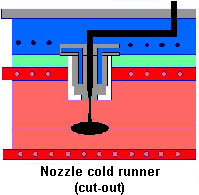
+ - Perfluoro rubber (FFPM)
Perfluoro-elastomer is a fully fluorinated elastomer. Chemically it is very similar to polytetrafluoroethylene (PTFE, trade name: Teflon ®). It is mainly used where excellent thermal and chemical resistance are required. Perfluoro-rubber is the most expensive technical specialty elastomer.
Temperature range: -20 ° C to +335 ° C
FFPM is available in a hardness range between 70 and 90 Shore A.
Areas of application: seals and molded parts that come into contact with aggressive media and high temperatures, especially in systems with high safety standards and extreme service and maintenance costs.
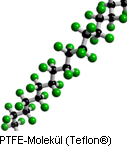
+ - Polyacrylate rubber (ACM)
ACM has a high resistance to oxygen, ozone and high temperatures and a good swelling resistance in mineral oils however a high water absorption and a bad hydrolysis resistance. Ethylene acrylate rubber (AEM) is known under the trade name VAMAC from the company DU PONT. AEM has characteristics like ACM, however a better rigidity, heat resistance, but worse mineral oil resistance.
ACM is for Shore-hardness Shore A 40-90 available.
Areas of application: Seals in automobile construction, hoses, O rings.
+ - Polyurethane rubber (EU)
Polyurethane rubbers are characterised through an excellent wearing conduct, extraordinary high tensile strength, high elasticity in the overall hardness area and a good resistance to radiation full of energy. They are furthermore resistant to oxygen, ozone, mineral oils and grease. The hydrolysis resistance compared to watery media is however limited.
EU is for Shore-hardness Shore A 55-90 available.
Areas of application: Wipers, gears, full rubber wheels, rolls and roll coverings and in general especailly wear-resistant technical rubber moulded parts.
+ - Primer
Primers are adhesive agents which are used to improve the adhesion characteristics in 2 component adhesion systems. Primers do not contain cross-linking agents so that the binding to thesubstrate is exclusively based on physical energy (adhesion) .
+ - Rheometer
Rheology (from the greek rhei = flow and logos = doctrine) deals with the deformation und flow characteristics of materials. Rheometer stands for measuring devices which are used to determine the deformation and flow behavior.
In the rubber industry the rheometer is applied for the determination of the flow characteristics of rubber compounds. During the vulcanization the viscosity of the compound rises heavily and reaches a maximum after the finishing of the vulcanization process. The rheometer measures the strength during the vulcanization which is needed for the deformation of the test specimen.
The change of the strength over the time is called the rheometer curve. These curves help to evaluate the quality of the rubber compound. They also help to adjust production parameters for the processing of compounds.
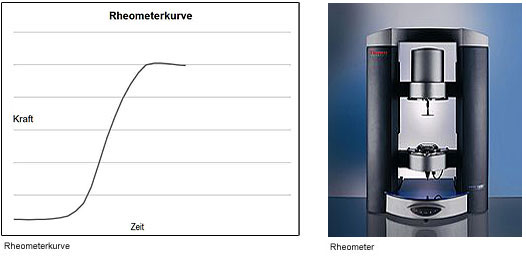
+ - Rubber
is the unvulcanized raw material in the production of elastomers (rubber). Depending on the origin a distinction is made between natural and synthetic rubbers.
+ - Rubber hybrid parts
Rubber bonded parts (rubber hybrid parts)
In principle for the production of rubber bonded parts there are 2 possibilities:
1. The gluing of vulcanized rubber mixtures on metals or plastics.
2. The vulcanizing of the rubber mixtures on metals or plastics using
adhesive agents.
In practice the gluing of vulcanized material is only rarely used since even the use of very high-quality glues (e.g. cyanacryiate glue) does not reach the adhesive strength which can be reached with the direct vulcanizing.
+ - Rubber metal combinations
Steel is the most used material for rubber - metal combinations, however also other metals like titan, aluminium, brass, zinc and alloys are used.
+ - Rubber plastic combination
The replacement of metals in rubber metal combinations through suitable plastics has, in addition to the reduction of weight, 2 further advantages. On the one hand plastics do not corrode, on the other hand also complex plastic parts can be rationally produced through injection moulding.
Plastics are usually degreased similar to metals and mechanically prepared, as well as coated with an adhesive agent. The thermoplastics used for the production of rubber plastic combinations must be dimensionally stable with the applied vulcanization temperatures of 160 - 200°C. Otherwise with the production of moulded parts there is a demouldation of the plastic part.
In exceptional cases also a steadily adhesive rubber plastic combination without the use of adhesion agents is possible. This requires however very special rubber thermoplastic combinations.
+ - Shore-hardness
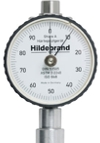 The measuring of shore hardness according DIN ISO 7619-1 is the most applied measurement of the elastomer hardness. The shore hardness gives the resistance of a rubber part towards the penetration of a cone-shaped pin with determined dimensions under a defined pressure. Shore A for softer compounds and Shore D for harder compounds is determined by the type of measuring pin.
The measuring of shore hardness according DIN ISO 7619-1 is the most applied measurement of the elastomer hardness. The shore hardness gives the resistance of a rubber part towards the penetration of a cone-shaped pin with determined dimensions under a defined pressure. Shore A for softer compounds and Shore D for harder compounds is determined by the type of measuring pin.
To receive a perfect measuring result of the shore hardness the test specimen must have a thickness of 6 mm. In many cases the measurement on finished parts with a small rubber wall thickness leads to wrong results.
Standard elastomer compounds for technical rubber moulded parts are lying in a range from 20 to 90 Shore A.
Besides the Shore hardness test with a cone shaped gauging tip there exists the IRHD test according DIN ISO 48 with a ball shaped gauging tip.
+ - Silicon rubber (VMQ)
Silicon elastomers are distinguished from other elastomers through the fact that they are not purely organic compounds. Instead of carbon polymer chains of the normal elastomers, the silicon polymer chain alternatively consists of silicium and oxygen atoms (siloxane). Silicon rubbers are processed as solid rubber and usually peroxidically cross-linked or processed as liquid rubber and usually cross-linked by addition.
Silicone elastomers have a good resistance to heat, ozone and ageing as well as a good resistance to chemicals. The mechanical characteristics however are rather below those of the other elastomers. Silicone rubbers are characterised through the almost unchanged mechanical characteristics over the entire temperature range of -60°C to +180°C. In order to obtain optimal heat resistance and a low pressure permanent set, a post tempering is necessary in many cases.
VMQ is for Shore-hardness Shore A 30-85 available.
Areas of application: Seals for deep freezers, stoves, drying cabinets, windows and cabin doors of airplanes, shaft seals, O rings, shutdown mats, medical-technical items, electric isolators.
+ - Statistical Process Control (SPC)
Statistical Process Control (= SPC) is a continuous accompanying monitoring of manufacturing processes by capturing all relevant to the product quality metrics. The SPC provides the basic data to identify weaknesses and thus the requirement for continuous improvement of their production processes. It may have both quantitative and qualitative characteristics of a product or a process to be monitored.
Data collection and evaluation is done using control charts as a graphical tool, a process over a longer period of time continuously monitored.
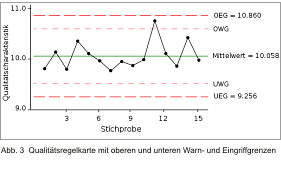
In quality control charts warning limits (UWG, OWG) and control limits (LEL, UEL) are defined, above which indicates an irregularity or an error. If you exceed the warning limits means that the process still lies within its tolerances, but a readjustment or intervention is required. Control charts providing an early warning system to prevent errors and committee. Already at the first sign of a mistake can be taken in the process and not only when exceeding the tolerance limits.
+ - Stick-Slip-Effekt
The stick-slip effect is derived from the terms "stick" (sticking) and "slip" (gliding). The phenomenon describes the jerky sliding of solids, which slide against each other (sticking is significantly greater than sliding friction).
This unwanted effect can also be observed at dynamically stressed sealing. Due to high pressures, higher temperatures and longer standstill times there will be a more aggravated resolution of the armature. The “sticking” mainly leads to
- a higher power input in the starting phase at electro-magnetic valves
- increased pressure at pneumatic and hydraulic valves or even to
- a malfunction and following PTFE slide coating
Therefor appropriate measures are needed to avoid such an effect as use of
- plasma treated elastomer surfaces
- combination of plasma treatment and following carbon treatment
- combination of plasma treatment and following fluor treatment
- combination of plasma treatment and alternative special coatings
- friction modified compounds with a friction-reducing polymer filler
- reduction of tolerances and less pressure of the seal seats
- design optimization of the sealing geometry
Depending on the special case you will have to decide which of the named processes are best to solve your stick-slip-problem.
+ - Strained rubber compounds
The word "strained" means "sieving" or "filtering".
In connection with rubber compounds, strained is used when, after the actual mixing process, in a further step in an extruder the compounds are pressed through a very fine-meshed sieve. In many cases, mesh widths of less than 0.5 mm are used. Impurities are retained in the sieve and removed from the compound batch.
Strained rubber compounds are used especially for products in medical technology, the semiconductor industry, but also for the high-end automotive sector.
On the basis of computed tomographic analyses, it can be shown that the finished parts made from strained compounds have a very homogeneous elastomer structure without disturbing foreign inclusions.
+ - Styrol butadiene rubber (SBR)
The styrol butadiene rubber is the oldest and with regards to the used amount the most important synthetic rubber. Compared to NR, SBR features a better wearing resistance, better heat and ageing resistance, but lower elasticity and a worse cold flexibility. The mineral oil resistance is somewhat better than with NR.
SBR is for Shore-hardness Shore A 35-90 available.
Areas of application: Two thirds of the world production is used for the production of tyres. Other applications like with NR. Very often NR is blended with SBR, e.g. with the production of tyres.
+ - Surface tension
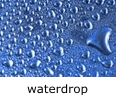 Fluids have the ambition to reduce theit surface and to take the energetic most favourable form of a ball-shaped drop (e.g. a waterdrop). This phenomenos is called surface tension. The surface tension is measured in the SI unit N/m. The surface tension is also called interfacial tension which is effective between the interfaces of two materials in any phase.
Fluids have the ambition to reduce theit surface and to take the energetic most favourable form of a ball-shaped drop (e.g. a waterdrop). This phenomenos is called surface tension. The surface tension is measured in the SI unit N/m. The surface tension is also called interfacial tension which is effective between the interfaces of two materials in any phase.
Interface active substances like oil or grease minimize the surface tension. The quality of a rubber to plastic or rubber to metal bonded part is essentially determined by the use of carrier surfaces free from oil and grease.
The surface tension and, at the same time, the freedom of grease of the surface of a metal or plastic part can be determined by the so-called ink-test-method.
+ - Thermoplastic elastomers (TPE)
Thermoplastic elastomers (TPE) are plastics that behave similar to conventional elastomers at room temperature, but which can deformed plastically at increasing temperatures. Normal elastomers are chemically wide-meshed crosslinked polymer chains. The crosslinks cannot be solved without decomposition of the material.
 Thermoplastic elastomers have partly physical crosslinking points,
Thermoplastic elastomers have partly physical crosslinking points,
which dissolve on heating without decomposing the macromolecules. So they can be processed on thermoplastic injection molding machines to moulded parts. The easier workability and good recycling capacity is conflict with a relatively high price for TPE compounds.
In recent years, the thermoplastic elastomers have been significantly optimized in their property profiles. They are now found in many soft-touch applications, such as handles or protective casings. The replacement of the elastic rubber by a TPE material is not possible in many cases.
By crosslinking (vulcanization) of the classical elastomer you achieve mechanical and chemical resistance values that are not obtained by thermoplastic materials. Therefore, TPE compounds are not used in the manufacture of vehicle tires.
+ - Transfer moulding cold runner
Transfer moulding cold runners are used with compression transfer moulding processes (CTM) or with injection transfer moulding processes (ITM) for the production of rubber moulded parts. The transfer unit is cooled through a cooling agent and thermically separated through an insulation plate from the heated vulcanization zone of the mould. Usually water is used as a cooling agent. The transfer from the cooled to the heated zone follows through nozzle elements.
In contrast to nozzle cold runners with transfer moulding cold runners the nozzle elements are not cooled individually but rather through the entire cooling block. The elastomer material found in the transfer units does not vulcanize with each production cycle and can be used in the following cycle for the production of moulded parts.
While the nozzle cold runners usually are used with small calibre numbers and larger moulded parts, transfer moulding cold runners are better suitable for high calibre numbers of rather small volumes of rubber moulded parts.
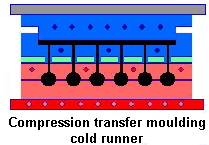
+ - Vulcanization
Vulcanization is the chemical-physical change in which the predominantly plastic rubber transmoulds into the rubber elastic condition. This process which follows through the coupling of macromolecules to the reaction points is also called cross-linking. For vulcanization you need a vulcanization agent. The oldest and most common vulcanization agent (cross-linking agent) is sulphur.
